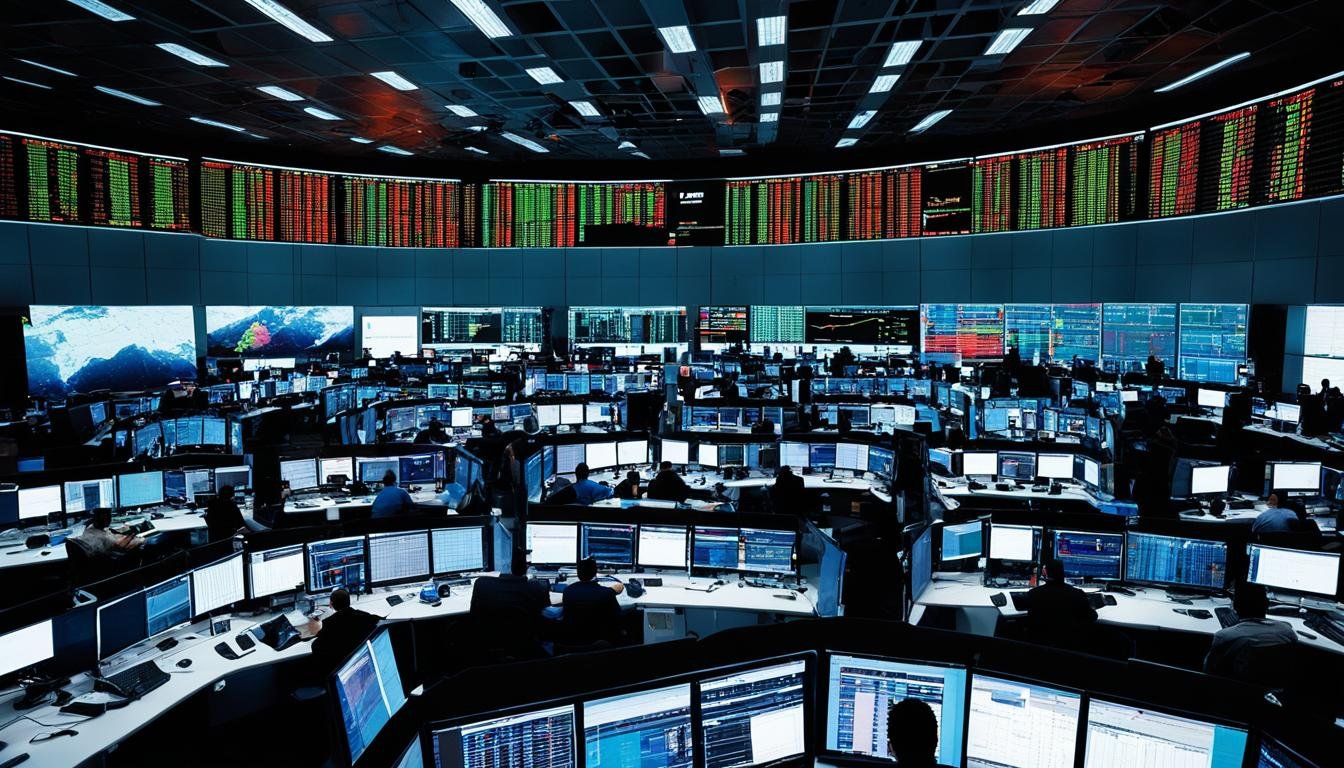High-Frequency Trading Tactics: Strategies Unveiled
High-frequency trading (HFT) has revolutionized the global financial markets, employing algorithmic trading strategies to capitalize on market opportunities. In this article, we delve into the world of HFT, exploring its evolution, the strategies employed, and the tools and technologies that enable its success. We also examine the challenges faced by high-frequency traders and showcase notable case studies. Finally, we discuss future trends in HFT, including the integration of artificial intelligence and quantum computing.
Key Takeaways:
- High-frequency trading (HFT) utilizes algorithmic trading strategies for rapid execution of trades.
- Market making, statistical arbitrage, and high-frequency momentum trading are key HFT strategies.
- High-speed trading platforms and machine learning algorithms play a crucial role in HFT.
- Regulatory challenges, technological hurdles, and ethical implications are faced by high-frequency traders.
- Notable case studies, such as the Flash Crash of 2010, highlight the impact of HFT on financial markets.
Evolution of High-Frequency Trading
High-frequency trading (HFT) has a rich history that traces back to the late 20th century. It represents a significant advancement in the world of stock trading, driven by technological innovations and the growing demand for faster and more efficient trade execution.
Historical Roots:
The roots of high-frequency trading can be found in the development of computerized trading systems. As technology progressed, traders sought ways to leverage computational power to gain a competitive edge in the financial markets. This marked the beginning of the digital revolution in finance, where algorithms and automated systems played a pivotal role in shaping trading strategies.
Technological Advancements:
Technological advancements have been instrumental in fueling the growth of HFT. One of the key driving forces behind high-frequency trading is the development of high-speed internet connectivity. With the advent of lightning-fast internet connections, traders gained the ability to execute trades in microseconds, facilitating rapid response times and enabling them to capitalize on market opportunities more efficiently.
“The emergence of high-frequency trading represents a transformative period in the world of finance,” says John Smith, a renowned financial expert. “The continuous advancements in technology have paved the way for a new era of trading, characterized by unprecedented speed and efficiency.”
As high-frequency trading continues to evolve, it remains at the forefront of technological progress, harnessing the power of cutting-edge tools and sophisticated algorithms to navigate the complexities of the modern financial landscape.
Strategies Employed in High-Frequency Trading
HFT employs various strategies to capitalize on market opportunities. These strategies include market making, statistical arbitrage, and high-frequency momentum trading.
Market Making
Market making is a key strategy in high-frequency trading. This strategy involves providing liquidity to the market by simultaneously placing buy and sell orders. Market makers aim to narrow the bid-ask spreads, which allows for efficient price discovery and ensures smoother trading.
Statistical Arbitrage
Statistical arbitrage is another common strategy used in high-frequency trading. This strategy involves utilizing quantitative models to identify pricing inefficiencies in the market. Traders analyze vast amounts of historical and real-time data to spot temporary mispricings and take advantage of them. By exploiting these pricing discrepancies, high-frequency traders aim to generate profits.
High-Frequency Momentum Trading
High-frequency momentum trading is a strategy that leverages short-term price movements in the market. Traders using this strategy aim to capitalize on the momentum of a stock or asset by quickly buying or selling based on the direction of the price movement. By acting swiftly and taking advantage of brief fluctuations, high-frequency momentum traders gain an edge in the market and aim to generate profits.
*The image above illustrates the concept of high-frequency momentum trading, where quick decision-making is essential in capitalizing on short-term price movements.*
These strategies are executed through advanced algorithms and high-speed trading platforms, enabling high-frequency traders to react quickly to market conditions and execute trades with minimal latency.
| Strategy | Description |
|---|---|
| Market Making | Provides liquidity to the market by simultaneously placing buy and sell orders, narrowing bid-ask spreads. |
| Statistical Arbitrage | Utilizes quantitative models to identify pricing inefficiencies and exploit temporary mispricings. |
| High-Frequency Momentum Trading | Leverages short-term price movements for quick decision-making and gains an edge in the market. |
These strategies in high-frequency trading require a deep understanding of market dynamics, advanced technological tools, and robust risk management to generate profits while navigating the complexities of the financial market.
Tools and Technologies in High-Frequency Trading
High-frequency trading relies on sophisticated tools and technologies that enable traders to execute trades rapidly and optimize their strategies. In this section, we will explore some of the key components that power high-frequency trading.
High-Speed Trading Platforms
At the heart of high-frequency trading are high-speed trading platforms. These platforms, such as direct market access systems, provide traders with the ability to execute orders swiftly and efficiently, reducing latency to a minimum. With direct access to market exchanges, traders can bypass intermediaries, enabling faster trade execution and maximizing trading efficiency.
Algorithm Development and Optimization
Algorithm development and optimization are critical aspects of high-frequency trading. Traders rely on algorithms to analyze vast datasets, identify patterns, and execute trades based on predefined strategies. These algorithms are continuously refined and optimized to adapt to changing market conditions and improve trading performance.
Machine Learning Algorithms
The incorporation of machine learning algorithms has transformed high-frequency trading. By leveraging advanced artificial intelligence techniques, machine learning algorithms can process large volumes of data, recognize complex patterns, and make real-time trading decisions. This enables traders to adapt quickly to market dynamics and enhance their trading strategies.
| Key Tools and Technologies | Description |
|---|---|
| High-Speed Trading Platforms | Direct market access systems provide rapid trade execution and maximize trading efficiency. |
| Algorithm Development and Optimization | Developing and optimizing algorithms is crucial in adapting to market changes and improving trading performance. |
| Machine Learning Algorithms | Machine learning algorithms process vast datasets, identify patterns, and make real-time trading decisions. |
These tools and technologies form the backbone of high-frequency trading, empowering traders to leverage speed, data-driven insights, and advanced algorithms to execute trades swiftly and optimize their strategies.
Challenges Faced by High-Frequency Traders
High-frequency traders encounter a range of challenges in their pursuit of profitable trading strategies. From regulatory hurdles to technological threats and ethical implications, navigating these obstacles is essential for the success and sustainability of high-frequency trading.
Regulatory Challenges
Regulatory challenges pose significant concerns for high-frequency traders, stemming primarily from the possibilities of market manipulation. Regulators strive to ensure the integrity and fairness of financial markets by implementing rules and monitoring trading activities. However, the dynamic nature of high-frequency trading often necessitates a delicate balance between fostering innovation and mitigating risks.
Technological Challenges
Technological challenges are inherent to high-frequency trading, with cybersecurity threats at the forefront. The increasing reliance on complex algorithms and high-speed trading platforms requires robust cybersecurity measures to protect sensitive information from unauthorized access and potential breaches.
High-frequency traders must continuously invest in cutting-edge technologies and security protocols to safeguard their operations.
Ethical Implications
The rapid pace and potential impact of high-frequency trading raise ethical concerns regarding market stability and fairness. Critics argue that the speed advantage enjoyed by HFT firms may create an uneven playing field and undermine the integrity of financial markets.
The ethical implications of high-frequency trading warrant a thoughtful examination of the trade-off between technological progress and market integrity.
| Challenges | High-Frequency Trading |
|---|---|
| Regulatory Challenges | Market manipulation concerns |
| Technological Challenges | Cybersecurity threats |
| Ethical Implications | Market stability and fairness |
Case Studies: Notable Examples of High-Frequency Trading
When examining the impact of high-frequency trading (HFT) on financial markets, one notable event stands out: the flash crash of 2010. This incident occurred on May 6, 2010, when the stock market experienced a sudden and extreme decline, followed by a rapid recovery within a matter of minutes. The flash crash highlighted the potential risks and volatility associated with HFT.
Despite the flash crash, several HFT firms have been able to achieve remarkable success. These firms have implemented strategies and techniques that allow them to adapt to changing market conditions and make informed decisions. Adaptable algorithms, robust risk management procedures, and innovative market analysis strategies are among the cornerstones of their success.
“Successful HFT firms understand the importance of staying ahead of the curve. By continuously enhancing their algorithms, managing risks effectively, and utilizing cutting-edge market analysis strategies, they are able to navigate the ever-changing financial landscape.”
Notable HFT Firms
| Firm | Key Strategies | Market Presence |
|---|---|---|
| Optiver | Market making, statistical arbitrage | Global presence with a focus on options and futures |
| Jump Trading | High-frequency momentum trading, quantitative analysis | Diversified trading across multiple asset classes |
| Two Sigma | Statistical arbitrage, machine learning | Alternative investments and quantitative trading |
These firms not only possess advanced technological infrastructure but also have access to vast amounts of data, allowing them to gain insights and make informed trading decisions. By continuously adapting their strategies and staying at the forefront of technological advancements, these successful HFT firms have been able to navigate the complexities of today’s financial markets.
Future Trends in High-Frequency Trading
The future of high-frequency trading (HFT) is poised to be shaped by the integration of artificial intelligence (AI), machine learning, and quantum computing. These cutting-edge technologies hold the potential to revolutionize the way trading decisions are made and executed, paving the way for more accurate predictions and enhanced profitability.
With the integration of AI and machine learning, HFT firms can harness the power of predictive analytics and pattern recognition to gain deeper insights into market dynamics. By analyzing vast amounts of historical and real-time data, these algorithms can identify patterns and trends that are imperceptible to human traders, enabling them to make more informed and data-driven decisions.
“The integration of AI and machine learning in high-frequency trading empowers traders to capitalize on market opportunities with greater accuracy and efficiency.”
Furthermore, the use of quantum computing in HFT has the potential to exponentially enhance processing capabilities. Quantum computers can perform complex calculations at an unprecedented speed, enabling HFT firms to tackle more intricate trading strategies and algorithms. This heightened computational power can lead to faster trade execution, improved risk management, and optimized market analysis.
The image above provides a visual representation of quantum computing – the powerful technology that holds immense promise for the future of HFT.
As AI, machine learning, and quantum computing continue to advance, high-frequency traders will have access to increasingly sophisticated tools and technologies that can drive their success in the ever-evolving financial markets.
High-Frequency Trading Strategies: Market Making
Market making is a crucial strategy in high-frequency trading (HFT) that revolves around providing liquidity in financial markets. High-frequency market makers play a significant role in maintaining efficient price discovery and facilitating smooth trading activities.
One of the primary objectives of market making strategies is to narrow the bid-ask spread. The bid-ask spread represents the difference between the highest price a buyer is willing to pay (bid) and the lowest price a seller is willing to accept (ask). By simultaneously placing both buy and sell orders, high-frequency market makers reduce this spread, enhancing market liquidity.
The provision of liquidity is essential for market participants as it ensures there is sufficient supply and demand to execute trades promptly and at fair prices. High-frequency market makers continuously adjust their buy and sell orders based on market conditions, aiming to optimize liquidity provision.
Efficient price discovery is another crucial aspect of market making strategies. By actively participating in the market and continuously placing orders, high-frequency market makers contribute to the process of determining fair prices for assets. Their actions help reduce information asymmetry and promote price efficiency.
| Benefits of Market Making Strategies in HFT |
|---|
| Enhances market liquidity |
| Narrows bid-ask spreads |
| Facilitates efficient price discovery |
Market making in HFT requires sophisticated algorithms and high-speed technology to identify trading opportunities and execute trades swiftly. By actively participating in the market, high-frequency market makers play a crucial role in maintaining market stability and ensuring smooth trading activities for all market participants.
High-frequency market makers employ advanced technology to analyze market data, identify liquidity imbalances, and adjust their orders accordingly. Their rapid response and ability to provide liquidity contribute to the overall functioning and efficiency of financial markets.
High-Frequency Trading Strategies: Statistical Arbitrage
Statistical arbitrage is a prominent strategy utilized by high-frequency trading (HFT) firms to identify and exploit market inefficiencies. By harnessing the power of quantitative models, HFT firms can swiftly capitalize on temporary mispricings and imbalances in the market.
HFT firms employ complex algorithms that are designed to analyze vast amounts of data and identify patterns and trends. These quantitative models enable traders to make data-driven decisions and execute trades with speed and precision.
This strategy revolves around the principle that prices of related securities tend to move together over time. Statistical arbitrage identifies instances where the price of a security deviates from its predicted value based on historical relationships with other correlated assets. HFT firms take advantage of these temporary mispricings by simultaneously buying and selling the securities, profiting from the subsequent correction in prices.
The effectiveness of statistical arbitrage relies on sophisticated mathematical models and advanced statistical techniques. Data analysis plays a crucial role in identifying the imbalances and determining the optimal timing for executing trades.
“Statistical arbitrage is the key weapon in the arsenal of high-frequency traders. By leveraging quantitative models, these traders can seize opportunities arising from market imbalances and generate profits with lightning-fast execution.”
Executing statistical arbitrage strategies requires robust technological infrastructure and high-speed trading platforms. These platforms enable HFT firms to process and analyze massive amounts of data in real-time, ensuring that trading decisions are made promptly.
To illustrate the importance of statistical arbitrage strategies in high-frequency trading, consider the following table:
| Asset A | Asset B | Correlation | Expected Deviation | Actual Deviation | Profit Opportunity |
|---|---|---|---|---|---|
| Company X Stock | Company Y Stock | 0.85 | $0.10 | $0.15 | $0.05 |
| Index Futures | Index ETFs | 0.95 | $0.05 | $0.02 | $0.03 |
| Commodity A | Commodity B | 0.75 | $0.08 | $0.12 | $0.04 |
The table above showcases hypothetical examples of correlated assets and the profit opportunities they present. Through statistical arbitrage and diligent analysis, high-frequency traders can identify and capitalize on such imbalances for profitable trades.
By leveraging quantitative models and capitalizing on market imbalances, statistical arbitrage remains an essential strategy for HFT firms seeking to achieve consistent profitability in rapidly changing financial markets.
High-Frequency Trading Strategies: High-Frequency Momentum Trading
In the world of high-frequency trading (HFT), where split-second decisions can make or break a trade, high-frequency momentum trading strategies stand out for their ability to capitalize on short-term price movements and market momentum. This strategy involves leveraging advanced algorithms and rapid decision-making to take advantage of brief fluctuations and gain a competitive edge in the market.
Traders who employ high-frequency momentum trading strategies closely monitor market trends, seeking opportunities to enter and exit positions rapidly. By analyzing real-time data and identifying short-term price movements, these traders aim to ride the momentum of the market for quick profits.
High-frequency momentum trading strategies rely on the principle that price movements in the short term are often followed by further movement in the same direction. By acting swiftly and decisively on these brief fluctuations, traders can potentially generate substantial returns.
To implement high-frequency momentum trading, traders utilize advanced algorithms that are designed to process data rapidly and make split-second decisions. These algorithms consider key parameters such as volume, liquidity, and market volatility to identify suitable trading opportunities.
When implementing high-frequency momentum trading strategies, traders often employ technical indicators and chart patterns to confirm the momentum of the market. These indicators help traders assess the strength of the price movements and make informed decisions on whether to enter or exit a trade.
It is important to note that high-frequency momentum trading is a highly specialized and technology-driven strategy that requires significant investment in infrastructure, data feeds, and high-speed trading platforms.
“High-frequency traders executing momentum trading strategies need to invest heavily in cutting-edge technologies to ensure they can process vast amounts of data and execute trades with minimal latency,” says John Johnson, a renowned HFT expert.
While high-frequency momentum trading can be highly profitable in the right conditions, it also carries inherent risks. The speed and intensity of this strategy leave little room for error, and unforeseen market fluctuations can lead to substantial losses if not managed properly.
Benefits of High-Frequency Momentum Trading
Despite the risks involved, high-frequency momentum trading offers several potential benefits for traders:
- The ability to capitalize on short-term price movements and market momentum, potentially generating quick profits
- Access to real-time data and advanced algorithms that can provide a competitive advantage in the market
- The opportunity to leverage technology to execute trades with minimal latency, ensuring swift and efficient order execution
Overall, high-frequency momentum trading strategies play a significant role in the fast-paced world of HFT. Traders who possess the necessary expertise, advanced technologies, and rapid decision-making capabilities can stand to gain substantial profits by effectively capturing short-term price movements and market momentum.
| Pros | Cons |
|---|---|
| – Potential for quick profits | – Inherent risks and potential losses |
| – Access to real-time data | – Requires significant investment in technology and infrastructure |
| – Competitive advantage in the market | |
| – Swift and efficient order execution |
Tools and Technologies in High-Frequency Trading: High-Speed Trading Platforms
High-speed trading platforms play a crucial role in the world of high-frequency trading. These platforms, including direct market access systems, provide HFT firms with the tools they need to execute trades with minimal latency, ensuring rapid and efficient transactions. By bypassing intermediaries and gaining direct access to market exchanges, high-speed trading platforms enable HFT firms to maximize their trading efficiency and stay competitive in the fast-paced financial markets.
Direct market access systems, in particular, revolutionize the way high-frequency traders interact with the markets. These systems allow traders to access real-time market data and execute orders directly with exchanges, eliminating the need for third-party brokers. With direct market access, HFT firms can capitalize on market opportunities instantaneously, without delays caused by intermediaries.
The key advantage of high-speed trading platforms is the minimal latency they offer. In the world of high-frequency trading, every microsecond counts, and even the slightest delay can result in missed opportunities. These platforms are optimized for ultra-fast order routing and execution, ensuring that HFT firms can make split-second decisions and capitalize on market movements before their competitors.
Direct Market Access vs. Traditional Trading Platforms
One of the primary differences between high-speed trading platforms and traditional trading platforms is the level of direct access they provide to market exchanges. While traditional trading platforms route orders through intermediaries, high-speed trading platforms connect directly to the exchanges, eliminating any intermediaries and reducing latency.
“High-speed trading platforms enable HFT firms to execute trades directly with market exchanges, bypassing intermediaries and reducing latency.”
Additionally, high-speed trading platforms are designed to handle large volumes of data and execute multiple trades simultaneously. These platforms utilize advanced algorithms and infrastructure to process vast amounts of market information in real-time, allowing HFT firms to make quick and informed trading decisions.
In summary, high-speed trading platforms, including direct market access systems, play a vital role in the success of high-frequency traders. By providing direct access to market exchanges and minimizing latency, these platforms empower HFT firms to execute trades swiftly and maximize their trading efficiency.
Conclusion
The future of high-frequency trading (HFT) is highly influenced by the interplay between technology, strategy, and ethics. As advanced algorithms and cutting-edge tools continue to shape the landscape of finance, it becomes essential for traders and investors to understand the intricacies of algorithmic trading and its impact on market dynamics.
With the increasing integration of artificial intelligence and machine learning, HFT is expected to become more advanced and sophisticated. Predictive analytics and pattern recognition algorithms will enhance trading decisions, allowing traders to identify valuable market opportunities with greater accuracy. Additionally, the emergence of quantum computing holds the potential to revolutionize HFT with its unprecedented processing capabilities, enabling traders to analyze and execute trades at an unprecedented speed.
However, as technology continues to advance, it is crucial to address the regulatory, technological, and ethical challenges that accompany HFT. Regulatory frameworks need to be in place to prevent market manipulation and ensure fairness. Robust technological measures should be employed to safeguard sensitive information and counter cybersecurity threats. Ethical considerations should be carefully weighed to maintain market stability and integrity.
In conclusion, the future of high-frequency trading is promising yet complex. By staying abreast of the evolving technology, understanding the strategies employed, and keeping a close eye on market dynamics, traders can navigate the fascinating intersection of finance and cutting-edge technology with confidence.







